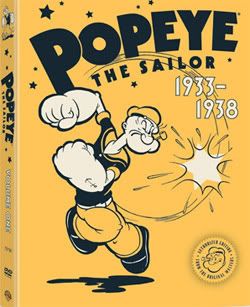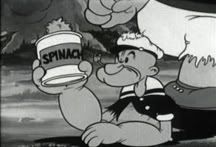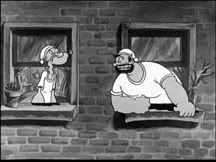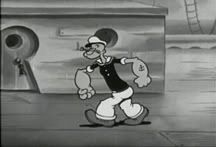He yam what he yam: Popeye is back
 OK, Popeye the Sailor Man is no spring chicken - he's 78 years old now. He's still strong to the finish because he eats his spinach, but admittedly, his days as a major cultural creative power are gone. He's a cartoon icon like Mickey Mouse – famous, but you're darned if you can remember what for exactly.
OK, Popeye the Sailor Man is no spring chicken - he's 78 years old now. He's still strong to the finish because he eats his spinach, but admittedly, his days as a major cultural creative power are gone. He's a cartoon icon like Mickey Mouse – famous, but you're darned if you can remember what for exactly.Well, all you need to do to learn what made Popeye world-famous is pick up the absolutely amazing new DVD set Popeye The Sailor Vol. 1: 1933-1938. Over four jam-packed discs, you'll find a platoon of the still-dazzling cartoons that drew in huge crowds nearly 70 years ago. These were some of the most popular cartoons ever made, spun out of the "Thimble Theatre" newspaper comic by E.C. Segar. Segar created Popeye as a throwaway character in 1929, but the rough-and-ready, hard-fighting, loyal and stubborn sailor man soon took over the whole strip. Segar's spunky 'toons have their own kind of populist genius, but it was the screen cartoons by the Fleischer brothers Max and Dave that made Popeye a global sensation. (Heck, a poll of theater owners back in the 1930s showed the sailor was even more popular than his big cartoon rival, Mickey Mouse.)
 Fleischer Studios' cartoons were some of the earliest animation creations, and their work still looks great today. The animators experimented with the possibilities of cartoons, packing every frame with gags, surreal action and slapstick. The new DVD set collects the first 60 cartoons by the Fleischers, all cleaned up and restored, but even more important, there's a wealth of special features here.
Fleischer Studios' cartoons were some of the earliest animation creations, and their work still looks great today. The animators experimented with the possibilities of cartoons, packing every frame with gags, surreal action and slapstick. The new DVD set collects the first 60 cartoons by the Fleischers, all cleaned up and restored, but even more important, there's a wealth of special features here.This set has been called "the best animation package ever put out on DVD" by comics writer and historian Mark Evanier. It's a cornucopia of material not just on the sailor man, but on the early days of animation in general, and it offers weeks of viewing. Many of the shorts feature commentary by animation experts and even a few surviving artists who worked on the films. There are two major documentaries, one a look at the creation and history of Popeye on film, one on the roots of animation from 1900 to 1920. You've even got mini-documentaries on everything from the use of music in the shorts to Olive Oyl's femininity (in a short marvelously titled, "Me Fickle Goyl, Olive Oyl: The World's Least Likely Sex Symbol"). As if all that wasn't enough, several dozen primitive pre-Popeye animated shorts dating back to 1915 are included as bonuses -- raw cartoons more interesting as time capsules now, true, but still a fascinating look at where the medium began, and how far it came in just 15 years or so.
 Of course, all 60 of these toons follow a rote basic plotline - Popeye encounters bad guy (usually Bluto), has fight, nearly loses until pulling out that magical can of spinach, cue thrilling music, final battle, roll credits. But it's the endless variations on this theme and the cunning artistry involved that make these animations so timeless. The figures quiver and dance, and the backgrounds are filled with endless sight gags. It's all a reminder that while hand-drawn animation seems a bit quaint these days, there's a homespun depth to it that modern stuff rarely has. It's all invested with the sense of novelty that these early animation pioneers must've felt -- they churned out one of these shorts every MONTH for years and yet they rarely cut corners and constantly came up with new ideas. It's all steeped in the gritty reality of the urban Depression years, somehow giving these outrageous cartoons a sense of reality that the more sanitized Disney product sometimes lacked. (Of course, there's a down side to the era, shown in the occasional dated politically incorrect short, such as the ones where Popeye beats up "red Indians.")
Of course, all 60 of these toons follow a rote basic plotline - Popeye encounters bad guy (usually Bluto), has fight, nearly loses until pulling out that magical can of spinach, cue thrilling music, final battle, roll credits. But it's the endless variations on this theme and the cunning artistry involved that make these animations so timeless. The figures quiver and dance, and the backgrounds are filled with endless sight gags. It's all a reminder that while hand-drawn animation seems a bit quaint these days, there's a homespun depth to it that modern stuff rarely has. It's all invested with the sense of novelty that these early animation pioneers must've felt -- they churned out one of these shorts every MONTH for years and yet they rarely cut corners and constantly came up with new ideas. It's all steeped in the gritty reality of the urban Depression years, somehow giving these outrageous cartoons a sense of reality that the more sanitized Disney product sometimes lacked. (Of course, there's a down side to the era, shown in the occasional dated politically incorrect short, such as the ones where Popeye beats up "red Indians.")The shorts really start to come into their own when the gruff and growling Billy Costello was replaced by Jack Mercer, who became the voice of Popeye for nearly 50 years. Mercer added a great deal of charm to Popeye through his muttering asides and grouchy wit. And of course, with quirky, hilarious supporting characters like Olive Oyl, the crude Bluto, mooching Wimpy and infant Swee'Pea, there were plenty of personalities for Popeye to play off of in the cartoons.
 The remastering is stunning. All but two of the shorts are black and white, but you'll barely notice, the images are so alive. Particularly amazing are the three-dimensional backgrounds created by the Fleischers' "Stereoptical" process, the details of which were long lost in previous muddy video releases. Two color "feature length" (or 20-minute) cartoons, "Popeye The Sailor meets Sindbad The Sailor" and "Popeye The Sailor Meets Ali Baba's 40 Thieves," are also included. The colors on these pop right off the screen.
The remastering is stunning. All but two of the shorts are black and white, but you'll barely notice, the images are so alive. Particularly amazing are the three-dimensional backgrounds created by the Fleischers' "Stereoptical" process, the details of which were long lost in previous muddy video releases. Two color "feature length" (or 20-minute) cartoons, "Popeye The Sailor meets Sindbad The Sailor" and "Popeye The Sailor Meets Ali Baba's 40 Thieves," are also included. The colors on these pop right off the screen.It's a shame it all had to end – during World War II, Fleischer Studios shut down (but not before also producing some legendary "Superman" cartoons as well). Popeye continued to romp through tales by Paramount and other studios, but they lacked that special combination of humor and invention that these earliest adventures had. By the 1970s, there was some truly dire material being pumped out with the Popeye name on it. It's a shame – because although they're nearly a century old, the material in these toons is still fresh and vital. If you wonder why Popeye became a household name, there's 60 cartoons' worth of reasons right here.
If you're any kind of fan of animation, Popeye or, heck, even spinach, this set is a must-have. It's one of the best DVD collections I've ever seen and a model for re-presenting vintage material with all the bells and whistles our modern era can sum up.

No comments:
Post a Comment